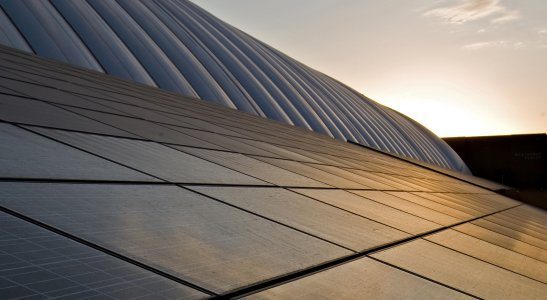SRP and Arizona State University (ASU) have teamed up to build a 1-megawatt, solar power plant on the Polytechnic campus in Mesa. The plant will feature the first commercial deployment of SunPower C7 Tracker technology. This solar photovoltaic tracking system concentrates the sun’s power seven times and is designed to achieve the lowest-leveled cost of electricity for solar power plants available today.
The SunPower solar power plant will utilize the C7 technology, but it won’t be the first solar power plant on the ASU Polytechnic campus. Two plants have already begun construction thanks to the SRP EarthWise Solar Energy Incentive Program.
“There are two other solar systems in construction at this time by Ameresco Southwest, a 298 kWdc and 511 kWdc,” says Jean Humphires, director of design and support services in the ASU Capital Programs Management Group. “Design of these systems began in August 2011; they will be operational by the end of March 2012.”
The ASU solar plant will be the third commercial-scale solar facility in the Valley of the Sun to provide energy for SRP, producing approximately the energy needed to serve about 225 SRP customers’ homes. The Polytechnic solar power plant will require minimal water use and supports ASU’s renewable energy goal to achieve 20-megawatts by 2014.
SunPower is engineering and constructing the plant on the southeast corner of the ASU Polytechnic campus and will operate and maintain it. Under a purchase-power agreement, SRP will buy the entire output of the solar plant from SunPower and, in a separate agreement, ASU will purchase all of the energy attributable to the plant for use at its Polytechnic campus, estimated to be more than two million kilowatts per year.
According to Humphries, 17 percent of the ASU Polytechnic campus peak load will be covered by the solar power plant, and the SunPower solar plant will be operational by the end of 2012.
The C7 Solar Power Technology
The C7 Tracker combines single-axis tracking technology with rows of parabolic mirrors, reflecting light onto 22.8 percent efficient SunPower Maxeon solar cells. The technology uses mirrors to reduce the number of solar cells required to generate electricity and will lower the levelized cost of electricity by up to 20 percent compared to other technologies. For example, the 1-megawatt C7 Tracker power plant at ASU will require only 172 kilowatts of SunPower solar cells.
“The SunPower C7 Tracker leverages SunPower’s depth of experience developing reliable tracking systems and delivers bankable technology with guaranteed performance,” says Howard Wenger, SunPower president. “We applaud our partners on this project in selecting this advanced technology platform that will deliver cost-effective renewable energy for the long-term.”
Integrating Solar Power Into Polytechnic Programs
There are four related educational and research programs on the Polytechnic Campus:
|
|
|
|
“The learning environment at the College of Technology and Innovation on the ASU Polytechnic campus is distinguished by a hands-on, project- and team-focused curriculum developed and delivered by faculty with extensive real-world experience,” says Mitzi Montoya, Vice Provost and Dean of the College of Technology & Innovation at Arizona State University. “Existing and new facilities on campus, like the Polytechnic solar plant, give our students opportunities to become more deeply engaged in their learning by providing applied context to classroom lessons.”




